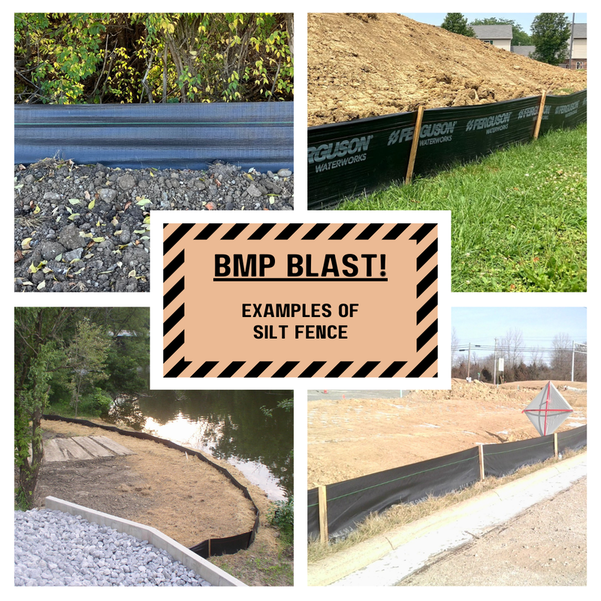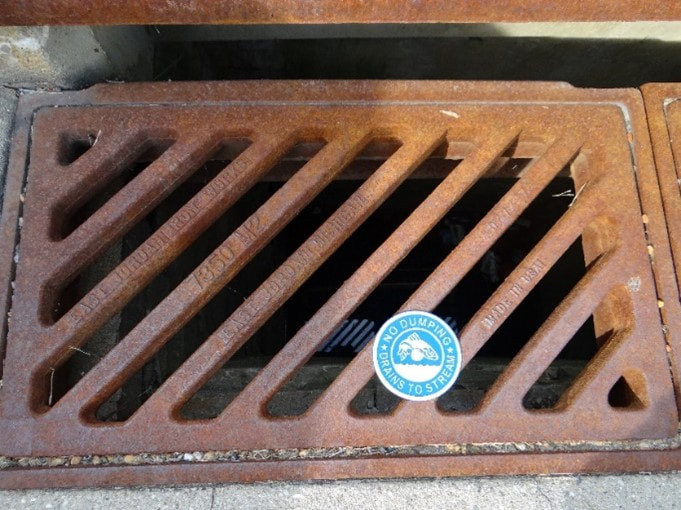|
BMP Blast: Silt Fence
What’s the first BMP that comes to mind when you think of construction site sediment control? Chances are you thought of silt fence (SF)! This month, we dig into how this relatively inexpensive practice is used and some common installation pitfalls to avoid. SF is a sediment-trapping barrier comprised of geotextile fabric and support posts. The fence is installed downslope of areas where sheet and rill erosion are expected to occur. Sediment-laden runoff ponds behind the fence and allows for deposition. Although it is a very popular and effective BMP, the Ohio Department of Natural Resources finds that about 75% of SF does not function due to poor installation. Here are some key points to follow:
Do not use SF…
What kind of maintenance does silt fence require?
Assess what caused the failure and make changes to prevent it from happening again. Is there a concentrated flow pointing at the fence? Did someone drive over it? Is the fence sufficiently trenched and compacted? Is the drainage area too big? For more details on the minimum criteria for SF fabric/posts and maximum slope length above SF, please refer to the Ohio Environmental Protection Agency’s (OEPA) Rainwater and Land Development Manual, Chapter 6.3.
2 Comments
In an effort to protect the health of our local waterways- rule 901:10-3-11 of the Ohio Administrative Code prohibits solid and liquid waste from being discharged into stormwater runoff. You know the drill- only rain should go down the drain!
Since the risk of stormwater pollution increases with construction activity and land development- the Ohio Environmental Protection Agency’s Construction General Permit (CGP) takes storm drain dumping prohibitions to another level. While the permit largely discusses sediment and erosion control measures, it also lists specific potential pollutants to be mindful of and requires a site-specific Stormwater Pollution Prevention Plan (SWPPP) be written and maintained. Prohibited Discharges
Other Potential Pollutants to Minimize
Spills and Unintended Releases Intentionally dumping waste down the drain is certainly prohibited but accidental discharges are just as serious and should be addressed immediately. Keeping up on your periodic site inspections is a great way to identify and address these problems. When possible, locate dumpsters, fueling stations, concrete washout areas, and portable bathrooms away from storm drains and watercourses. For more details on reportable quantities, please refer to this Release Reporting of a Hazardous Substance guide by the Ohio EPA. While an emergency can also constitute a violation, an emergency should be reported immediately to Ohio EPA’s 24-hour spill hotline at 1-800-282-9378 or 614-224-0946. Additional Resources Nearby Sanitary Landfills & Construction and Demolition Debris Facilities Ohio EPA NPDES General Construction Permit (OHC000006) Ohio Rainwater and Land Development Manual |
Details
Urban team BLOGEvery month, the Warren Co SWCD Urban Team dives deep into the world of land development as it relates to stormwater pollution prevention. The blog covers topics like erosion & sediment control best management practices (BMPs), state and local regulations, retention/detention basins, and the conservation of our natural resources. Stay up to date with Development Digest by signing up for WCSWCD Urban eNews!
Categories
All
Archives
April 2024
|
|
|
Contact:PHONE: (513) 695 - 1337
EMAIL: wcswcd@gmail.com HOURS: Monday - Friday 7:30am - 4:00pm (except holidays) Connect:Warren County Soil & Water Conservation District Copyright © 2016
Warren SWCD Privacy Notice. Emails are serviced by Constant Contact. Constant Contact's Privacy Notice. |


 RSS Feed
RSS Feed
